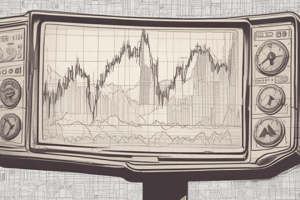Podcast
Questions and Answers
What is the primary goal of technical analysis in trading?
What is the primary goal of technical analysis in trading?
- To determine the value of a company
- To analyze company financial statements
- To predict future market trends and prices (correct)
- To identify market news and events
Which of the following is a type of technical analysis?
Which of the following is a type of technical analysis?
- Fundamental Analysis
- Economic Analysis
- Market Sentiment Analysis
- Chart Analysis (correct)
What is the purpose of a stop-loss in risk management?
What is the purpose of a stop-loss in risk management?
- To decrease potential losses (correct)
- To increase potential gains
- To establish a trading plan
- To monitor market news
What is the risk-reward ratio in risk management?
What is the risk-reward ratio in risk management?
What is the smallest unit of price movement in the Forex market?
What is the smallest unit of price movement in the Forex market?
What is the primary function of market makers in the Forex market?
What is the primary function of market makers in the Forex market?
Which of the following is a characteristic of the Forex market?
Which of the following is a characteristic of the Forex market?
What is the term for the overlapping trading sessions in the Forex market?
What is the term for the overlapping trading sessions in the Forex market?
Flashcards are hidden until you start studying
Study Notes
Trading Notes
Technical Analysis
- Definition: Study of charts and patterns to predict future market trends and prices
- Types:
- Chart Analysis: Study of charts to identify patterns and trends
- Indicator Analysis: Use of mathematical indicators to identify trends and patterns
- Key concepts:
- Support and Resistance: Levels at which prices tend to bounce back or break through
- Trend Lines: Lines connecting a series of highs or lows to identify trends
- Chart Patterns: Repeating patterns on charts, such as head and shoulders or triangles
- Indicators: RSI, MACD, Stochastic Oscillator, etc.
Risk Management
- Definition: Strategies to minimize potential losses and maximize gains
- Key concepts:
- Position Sizing: Determining the amount of capital to allocate to a trade
- Stop-Loss: Setting a price level to automatically close a trade and limit losses
- Leverage: Using borrowed capital to amplify potential gains and losses
- Risk-Reward Ratio: Calculating the potential profit versus potential loss of a trade
- Strategies:
- Diversification: Spreading risk across multiple trades or assets
- Hedging: Offsetting potential losses with opposing trades
- Scaling: Adjusting position size based on market conditions
Forex Markets
- Definition: Global market for trading currencies
- Key concepts:
- Currency Pairs: Trading one currency against another (e.g. EUR/USD)
- Exchange Rates: Price of one currency in terms of another
- Pip: Smallest unit of price movement (0.0001)
- Leverage: High leverage is common in Forex, amplifying potential gains and losses
- Market participants:
- Retail Traders: Individual traders
- Institutional Traders: Banks, hedge funds, and other large institutions
- Market Makers: Dealers who provide liquidity to the market
- Market hours:
- 24/5: Forex markets are open 24 hours a day, 5 days a week
- Overlapping sessions: European, US, and Asian sessions overlap, creating peak trading hours
Trading Notes
Technical Analysis
- Technical Analysis is the study of charts and patterns to predict future market trends and prices.
- It involves two types of analysis: Chart Analysis, which studies charts to identify patterns and trends, and Indicator Analysis, which uses mathematical indicators to identify trends and patterns.
- Key concepts in Technical Analysis include:
- Support and Resistance, which are levels at which prices tend to bounce back or break through.
- Trend Lines, which are lines connecting a series of highs or lows to identify trends.
- Chart Patterns, which are repeating patterns on charts, such as head and shoulders or triangles.
- Indicators, including RSI, MACD, and Stochastic Oscillator.
Risk Management
- Risk Management involves strategies to minimize potential losses and maximize gains.
- Key concepts in Risk Management include:
- Position Sizing, which determines the amount of capital to allocate to a trade.
- Stop-Loss, which sets a price level to automatically close a trade and limit losses.
- Leverage, which uses borrowed capital to amplify potential gains and losses.
- Risk-Reward Ratio, which calculates the potential profit versus potential loss of a trade.
- Risk Management strategies include:
- Diversification, which spreads risk across multiple trades or assets.
- Hedging, which offsets potential losses with opposing trades.
- Scaling, which adjusts position size based on market conditions.
Forex Markets
- The Forex Market is a global market for trading currencies.
- Key concepts in Forex Markets include:
- Currency Pairs, which trade one currency against another (e.g. EUR/USD).
- Exchange Rates, which are the prices of one currency in terms of another.
- Pip, which is the smallest unit of price movement (0.0001).
- Leverage, which is commonly high in Forex, amplifying potential gains and losses.
- Market participants in Forex Markets include:
- Retail Traders, who are individual traders.
- Institutional Traders, which are banks, hedge funds, and other large institutions.
- Market Makers, which are dealers who provide liquidity to the market.
- Forex Market hours include:
- 24/5, meaning the markets are open 24 hours a day, 5 days a week.
- Overlapping sessions, with European, US, and Asian sessions overlapping, creating peak trading hours.
Studying That Suits You
Use AI to generate personalized quizzes and flashcards to suit your learning preferences.




